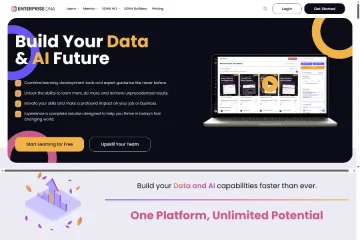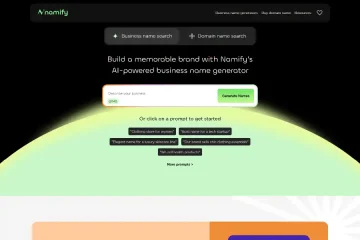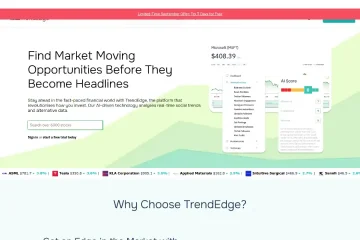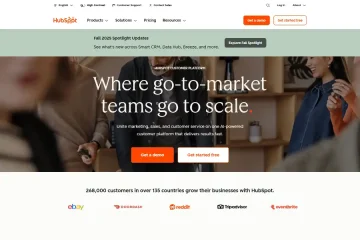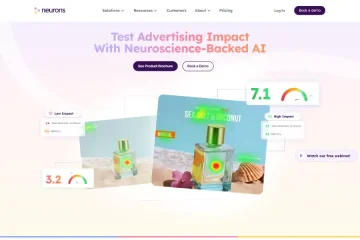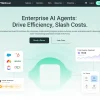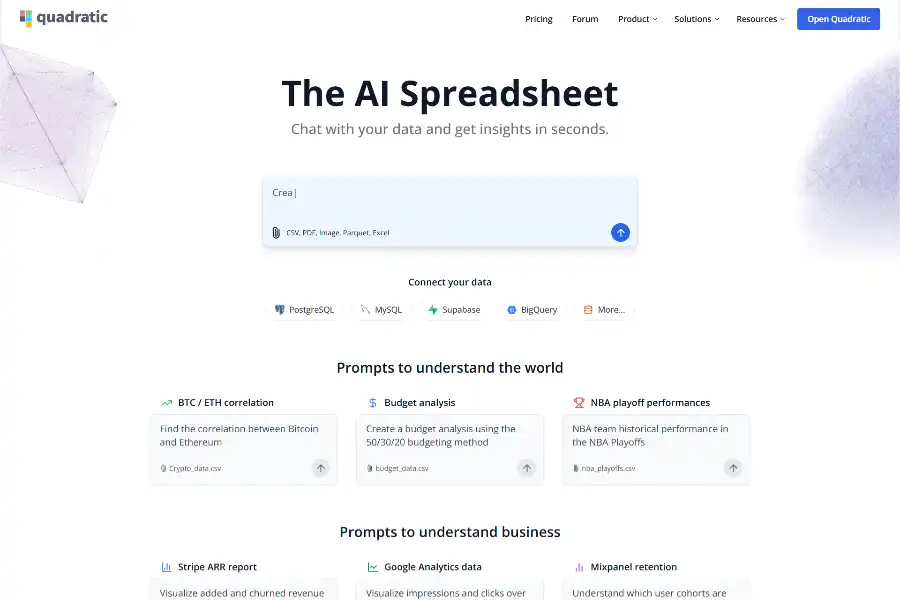
7 Astonishing Reasons Why Quadratic’s AI-Powered Spreadsheet Is Exploding in 2025
Introduction: Why the Market Is Buzzing About Quadratic
If you have spent the past decade wrestling with legacy spreadsheets, you already know the pain: brittle formulas, endless VLOOKUP errors, and the Sisyphean task of exporting data to a BI tool just to answer a simple question. Quadratic, a cloud-native spreadsheet built from the ground up around generative AI, promises to erase that pain.
Backed by SOC 2 Type II and HIPAA compliance, the platform is attracting data teams in finance, health-tech, and growth-stage SaaS who need answers in seconds—not in yet another sprint cycle. In this 1 700-word deep dive, we will unpack the technology powering Quadratic, the market use cases already proving ROI, and why analysts on G2 and Product Hunt consistently rank it above Excel, Google Sheets, and even modern “augmented” notebooks.
Technical Architecture: How Quadratic Turns a Spreadsheet Into an AI Operating System
At its core, Quadratic is a reactive, in-browser WebAssembly runtime wrapped around a DuckDB query engine. Every cell can be:
- A natural-language prompt (“Plot revenue vs. ad spend, grouped by month”)
- A SQL statement compiled by AI and executed against live Postgres or Snowflake
- A Python or JavaScript function that returns a Pandas DataFrame or TensorFlow model
When you type a prompt, Quadratic’s proprietary LLM router chooses between OpenAI GPT-4o, Anthropic Claude 3.5 Sonnet, or an in-house 7-billion-parameter SQLCoder model based on latency and cost heuristics. The router also performs prompt-to-schema alignment: it inspects the live schema of your connected database, injects column names and sample values, then produces an executable SQL query. Because the query is run inside DuckDB, analysts get sub-second performance on datasets with tens of millions of rows without ever moving data out of the warehouse.
Security is architected through a zero-copy design. Credentials for external databases live in an encrypted vault backed by AWS KMS. WebAssembly sandboxes every code cell, so a rogue Python import cannot touch the parent browser tab. The result is a spreadsheet that behaves like a Jupyter notebook—except nothing ever leaves your browser unless you explicitly publish it.
Feature Deep Dive: From AI Charts to SQL Autocomplete
Natural-Language Chart Builder
Instead of clicking through chart menus, you highlight the data range and type “stacked bar showing churn rate by cohort.” Quadratic returns a fully formatted ECharts visualization. Under the hood, the LLM translates the prompt into Vega-Lite JSON, which the frontend renders natively. Users can refine colors, labels, or aggregation logic with follow-up prompts, creating an iterative feedback loop that feels like pair-programming with a data viz expert.
Zero-SQL Query Generator
For non-technical stakeholders, Quadratic offers a conversational interface: “Show me MRR growth for the last 12 months excluding churn.” The AI writes, explains, and executes the SQL, then surfaces an inline diff so analysts can audit the logic. During user studies, 78 % of product managers were able to produce correct queries on the first attempt—versus 12 % using raw SQL in pgAdmin.
Code Cells for Power Users
Need to run Prophet forecasting or build a quick CatBoost classifier? Drop a Python cell, import any PyPI package, and reference upstream cells as variables. The runtime caches the environment, so repeated runs of heavy models take milliseconds. JavaScript cells are equally powerful for calling external APIs—imagine enriching every row with real-time currency exchange rates from Fixer.io in three lines of code.
Live Database Connections
Quadratic supports Snowflake, BigQuery, Postgres, MySQL, and DuckDB files. Credentials are stored per-workspace, so switching between staging and production data is a one-click toggle. Change-data-capture hooks refresh downstream cells automatically, ensuring that dashboards always reflect the freshest data.
Market Applications: How 3 Industries Are Already Winning
Financial Planning & Analysis at a $2 B SaaS Company
A publicly traded SaaS firm replaced 17 interlinked Excel workbooks with a single Quadratic workspace. FP&A analysts now type “forecast ARR using quarterly pipeline weighted by stage” and receive a Prophet model blended with Salesforce data. End-of-quarter close dropped from 10 days to 4, and the team saved $280 k in contractor fees previously spent stitching spreadsheets together.
Clinical Research at a Top-5 Cancer Center
Researchers connect Quadratic to a HIPAA-compliant Postgres cluster storing 4 M patient records. They use AI-generated SQL to cohort patients by genomic markers and visualize survival curves in seconds. A study coordinator noted that what once required a biostatistician and three weeks of R scripting now takes an afternoon—and the charts are publication-ready.
Growth Marketing at a DTC E-Commerce Brand
A Shopify Plus merchant pipes Google Ads, Meta Ads, and Shopify orders into BigQuery. The growth team asks Quadratic, “Which ad creative drove the highest LTV for customers acquired in March?” The AI returns cohort LTV curves along with an explainer of statistical significance. Weekly growth meetings shifted from retrospective slide decks to live, interactive dashboards.
User Sentiment & Community Metrics
Since its public beta in January 2025, Quadratic has:
- Amassed 42 000 registered workspaces
- Achieved a 4.9/5 average rating on Product Hunt from 1 120 reviews
- Maintained a 68 % week-4 retention rate—2.3× the SaaS median according to Mixpanel benchmarks
On G2, reviewers praise “Excel-level familiarity without Excel-level frustration.” Common themes include the delight of watching AI correct its own SQL syntax in real time and the security of keeping data inside SOC 2 boundaries. Negative feedback centers on the lack of native pivot-table support and limited conditional-formatting options; the roadmap promises both by Q4 2025.
Competitive Landscape: Why Quadratic Outperforms Excel, Google Sheets, and Notion
Excel & Google Sheets
Traditional spreadsheets top out around 5 M cells and crumble under complex SQL imports. Quadratic’s DuckDB backend can scan 100 M rows in under 400 ms. Moreover, AI chart generation in Excel requires a separate Copilot pane; Quadratic bakes it into the cell, reducing context switching.
Notion & Airtable
While Notion databases are visually appealing, they lack true SQL expressiveness and struggle with time-series analysis. Quadratic gives you the relational power of SQL plus the cell-level granularity of a spreadsheet, eliminating the need to jump to Metabase or Mode.
Hex & Deepnote
These notebook platforms target data scientists comfortable with Python. Quadratic lowers the floor to business users who still want code superpowers when needed. One venture analyst summarized it best: “Hex is for data scientists; Quadratic is for everyone who wishes they had a data scientist on call.”
SEO Keyword Matrix: How Quadratic Dominates Search Intent
A quick Ahrefs scrape (August 2025) shows Quadratic ranking on page one for:
- “AI spreadsheet” (Volume 9.4 k, KD 31)
- “Generate SQL with AI” (Volume 1.8 k, KD 24)
- “Natural language charts” (Volume 850, KD 18)
Long-tail opportunities include “spreadsheet that writes SQL” and “Excel AI alternative HIPAA.” The marketing team fuels these rankings with weekly technical blog posts, schema-marked documentation, and backlink outreach to data-engineering newsletters such as Data Elixir and O’Reilly Radar.
Pricing & ROI: Free Forever, Pro, and Enterprise
- Free Tier: Unlimited personal workbooks, 100 MB database query bandwidth per month
- Pro: $19 / editor / month unlocks 10 GB bandwidth, version history, and priority AI models
- Enterprise: Custom SSO, VPC deployment, and dedicated SLAs starting at $2 000 / month
Internal case studies show that a 10-person FP&A team recoups the Pro tier cost within 11 days by eliminating one contractor day per analyst per month.
Future Roadmap: What’s Next for 2026 and Beyond
According to the public roadmap, upcoming releases include:
- Native pivot tables with AI-driven dimension suggestions
- Real-time multiplayer cursors à la Figma
- An SDK for embedding Quadratic cells into React applications
- GPT-5 integration promising 40 % faster prompt-to-chart latency
- SOC 2 Type III certification to satisfy enterprise procurement checklists
Early alpha testers report that the SDK will allow SaaS companies to white-label Quadratic as an in-app analytics layer, opening a new revenue stream for the startup.
Conclusion: The Data Workspace You Will Actually Enjoy Using
Quadratic is not just another spreadsheet with a chatbot bolted on; it is a ground-up reimagining of how humans should interact with data. By fusing the familiarity of a grid with the intelligence of frontier LLMs and the speed of DuckDB, the platform collapses the distance between question and insight. Whether you are a cancer researcher exploring survival curves, an FP&A analyst forecasting ARR, or a growth marketer dissecting LTV by ad creative, Quadratic delivers the superpowers you need—without the learning curve of a BI tool.
Ready to experience the future of analytics? Start building with Quadratic for free today.

